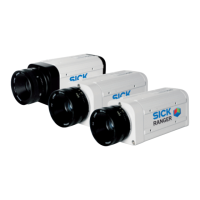Reference Manual Chapter 4
Ranger E/D
©SICK AG • Advanced Industrial Sensors • www.sick.com • All rights reserved 37
Ranger Studio
4.4.5 Getting a Complete Object in One Image
In many situations it is preferred to receive the measurement data for the objects in
separate buffers, so that each buffer contains the measurements of one single object.
This can be achieved in several ways, for example by adjusting the speed of the conveyor
belt or the profile rate from the Ranger, but also by specifying the number of scans to be
collected in the buffers.
When an external enable signal is used, the Ranger will always make a number of con-
secutive scans after the enable signal goes high. By using for example a photoelectric
switch to provide the enable signal, you can make sure that a fixed number of scans are
made for each object passing the switch.
The number of scans to make is specified by the Scan height parameter, and by setting
the buffer size in the frame grabber to the same value, you can assure that the measure-
ments of one object fits into one buffer.
It is important to synchronize the frame grabber and the Ranger when using the enable
signal this way, so that the first scan that the Ranger sends after the enable signal rises is
placed in an empty buffer. Otherwise the measurements of the object will be split into two
consecutive buffers (since the frame grabber will deliver a buffer to your application when-
ever it becomes full).
In this description, it is assumed that the measurement has been set up to use a photo-
electric switch or similar according to the above.
41. Make a measurement and from the resulting image estimate how many scans that
would be required to fit the complete object into one image.
42. Select the Measurement configuration in the parameter tree.
43. Select ScanHeight and set it to the estimate you made. This will make the Ranger send
this amount of scans for each trig pulse (after completion of previous collection of
scans).
44. Click Disconnect to synchronize the image buffers (the parameter settings of the Ranger
will remain in the Ranger unit).
45. Choose Options
Options… from the menu bar. A Ranger Option window appears.
46. Set the Lines per frame item to the very same value used for the ScanHeight parameter.
47. Depending on the number of lines per frame, it may also be necessary to increase the
Buffer size (that is, if a large value is used).
48. Click OK to close the window.
49. Click Connect to connect to the Ranger again.
50. Click Start to collect data and ensure that the complete object fits into one image. If
not, repeat the procedure again.
4.4.6 White Balancing the Color Data
The white balancing is necessary to ensure that proper color data is acquired. In a properly
white balanced measurement, white and grey objects give equal measurement values in
all three color channels, and objects appear with natural colors.
Note that no motion is needed for this process.
In this example it is assumed that the ColorRanger is configured to acquire color data, that
is the configuration contains a Color component that is enabled.
51. Select the Measurement configuration in the parameter tree.
52. Click Start in Ranger Studio.
53. Click on the Color tab.
54. Place a white or neutral gray object in front of the camera, so that it is visible for all
color rows.
55. Open a Profile zoom window by right-clicking and choosing from the zoom menu.

